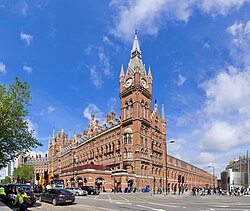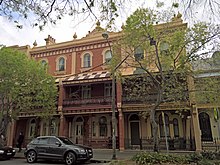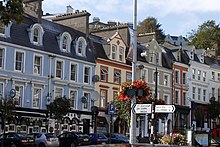Victorian architecture
During the early 19th century, the romantic medieval Gothic Revival style was developed as a reaction to the symmetry of Palladianism, and such buildings as Fonthill Abbey were built.In Scotland, the architect Alexander Thomson who practised in Glasgow was a pioneer of the use of cast iron and steel for commercial buildings, blending neo-classical conventionality with Egyptian and Oriental themes to produce many truly original structures.Other notable Scottish architects of this period are Archibald Simpson and Alexander Marshall Mackenzie, whose stylistically varied work can be seen in the architecture of Aberdeen.By the latter half of the century, however, improving transport and communications meant that even remote parts of the Empire had access to publications such as the magazine The Builder, which helped colonial architects keep informed about current fashion.Notable Victorian-inspired cities during this era include, Astoria in Oregon; Philadelphia and Pittsburgh in Pennsylvania; Washington, D.C.; Boston in Massachusetts; Alameda, Eureka, San Francisco, and Midtown Sacramento in California; The Brooklyn Heights and Victorian Flatbush sections of New York City, Garden City on Long Island, and Albany, Troy, Buffalo, and Rochester in Upstate New York; Asbury Park / Ocean Grove, Cape May, Deal, Flemington, Freehold, Hackettstown, Jersey City / Hoboken, Metuchen, Montclair, Ridgewood, Plainfield, Summit, and Westfield in New Jersey; Chicago, Galena, and Winnetka in Illinois; Detroit and Grand Rapids in Michigan; Cincinnati and Columbus in Ohio; Galveston in Texas; Baltimore in Maryland; Louisville in Kentucky; Atlanta in Georgia; Milwaukee in Wisconsin; New Orleans in Louisiana; Richmond in Virginia; St. Louis in Missouri; and Saint Paul in Minnesota.Los Angeles grew from a Pueblo (village) into a Victorian Downtown – now almost entirely demolished but with residential remnants in its Angelino Heights and Westlake neighborhoods.San Francisco is particularly well known for its extensive Victorian architecture, especially in the Haight-Ashbury, Lower Haight, Alamo Square, Western Addition, Mission, Duboce Triangle, Noe Valley, Castro, Nob Hill, and Pacific Heights neighborhoods.[9] The Old West End neighborhood of Toledo, Ohio is recognized as the largest collection of late Victorian and Edwardian homes in the United States, east of the Mississippi.Over-The-Rhine in Cincinnati, Ohio, has the largest collection of early Victorian Italianate architecture in the United States,[11][12][13] and is an example of an intact 19th-century urban neighborhood.[15] The photo album L'Architecture Americaine by Albert Levy published in 1886 is perhaps the first recognition in Europe of the new forces emerging in North American architecture.











St. Pancras railway stationLondonarchitectural revival stylesQueen VictoriaVictorian eraeclecticrevivalsHistoricismGeorgian architectureRegency architectureEdwardian architectureBritish EmpireSelwyn College, CambridgeBritish industrial architectureGothic Revival architecturemedievalGothic RevivalsymmetryPalladianismFonthill Abbeytechnologycast ironwrought ironiron frameJoseph Paxtonthe Crystal PalaceMentmore TowersEnglish RenaissanceAugustus PuginScotlandAlexander ThomsonGlasgowArchibald SimpsonAlexander Marshall Mackenziearchitecture of AberdeenNatural History MuseumJacobethanBritish Queen Anne RevivalRenaissance RevivalNeo-GrecRomanesque RevivalSecond EmpireFranceScots BaronialArts and Crafts movementItalianateNeoclassicalPalace of WestminsterCharles BarryRoyal Albert HallVictoria BuildingUniversity of LiverpoolAlfred WaterhouseThe OvalStroudGloucestershireHardwick HouseBury St EdmundsSuffolkManchester Town HallJohn Rylands LibraryAston WebbUniversity of BirminghamVictoria Law CourtsUniversity of GlasgowKelvingrove ParkBalmoral CastleScots Baronial styleWalsallBarclays Bank buildingSuttonForth Rail BridgeSomerville College, OxfordChina Merchants Bank BuildingThe BuilderWilliam ButterfieldSt Peter's Cathedral, AdelaideJacob Wrey MouldNew York CityCollins Street, Melbourneterraces in AustraliaSydneygold rushNew South WalesVictoriaFederationMelbourneRoyal Exhibition BuildingGeneral Post Office, SydneyHotel Windsor, MelbourneSydney Town HallQueen Victoria BuildingSouth Melbourne Town HallSt Mary's Cathedral, SydneyPrincess Theatre, MelbourneState Library of VictoriaGazeboAdelaide, South AustraliaRandwickSurry HillsFiligreeSouth YarraHong KongBritish colonySt. Andrew's ChurchSt. John's CathedralFormer Marine Police Headquarters1881 HeritageGeorgian squaresterracesWicklow StreetBaggot StreetPhibsboroGlasnevinRathminesRanelaghRathgarRathfarnhamTerenureGeorge's Street ArcadeRoyal City of Dublin HospitalRoyal Victoria Eye and Ear HospitalSri Lanka Law CollegeGalle Face HotelRoyal CollegePainted Ladies
